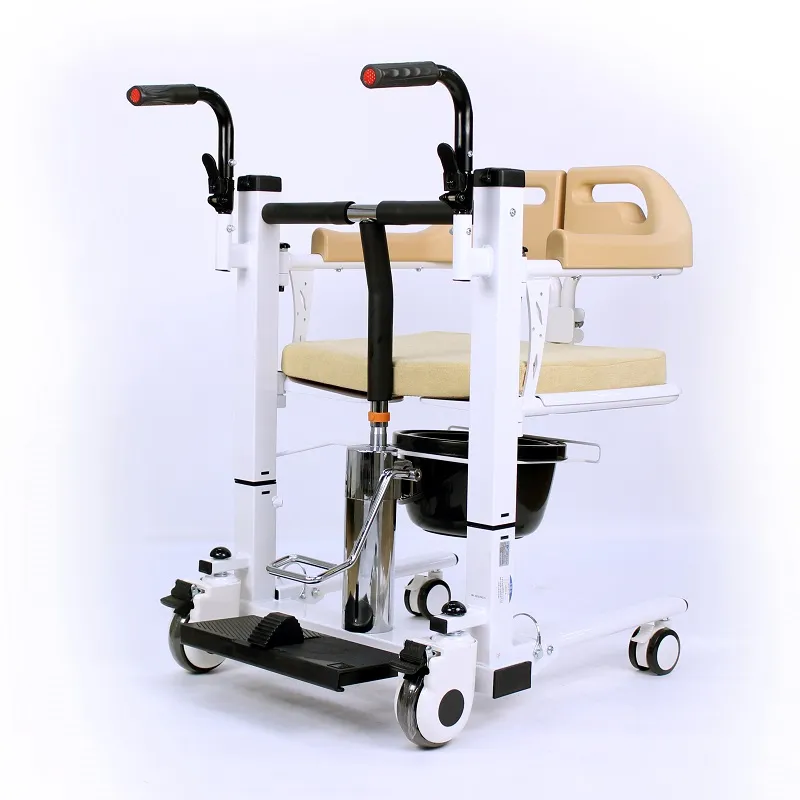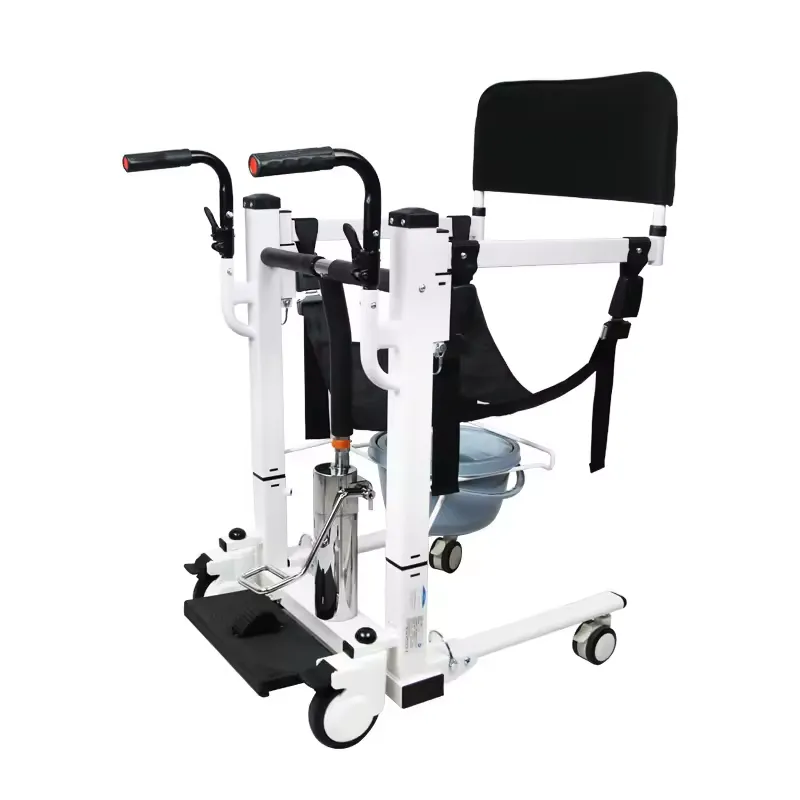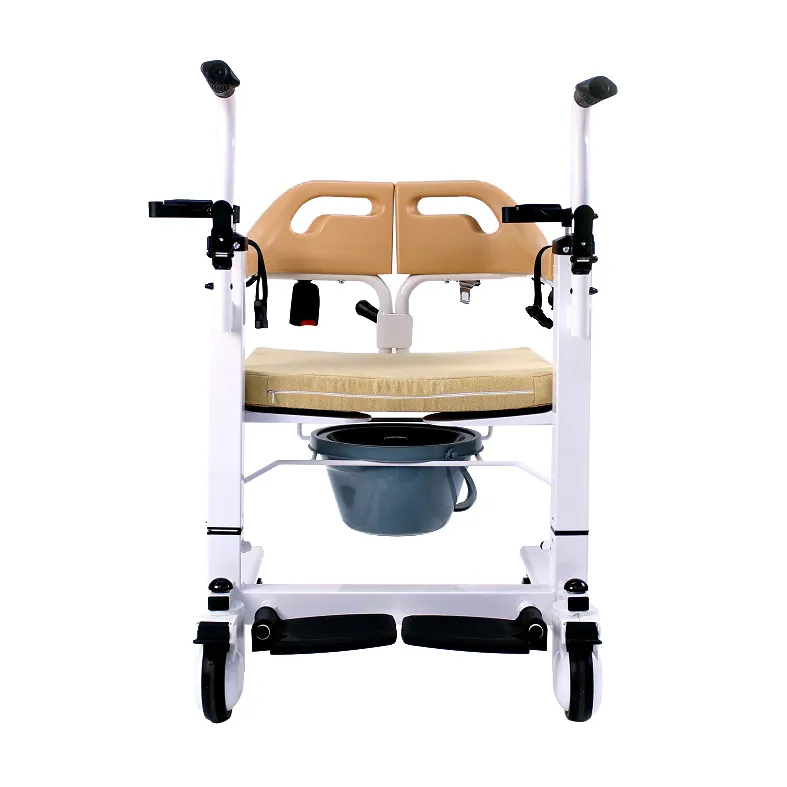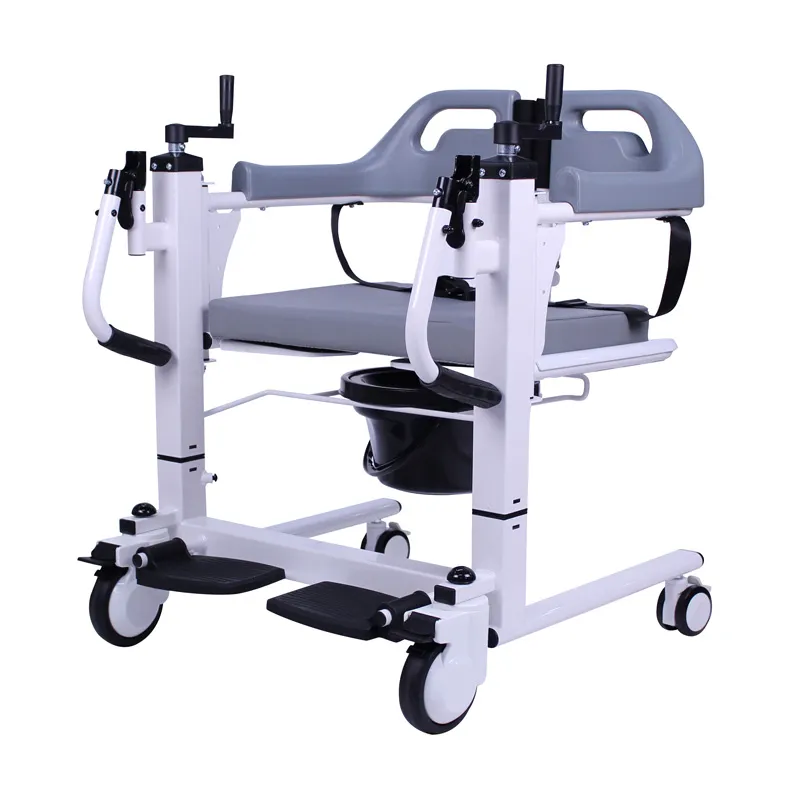With the accelerating aging of the global population, the number of people with disabilities and semi-disabilities is increasing, and the difficulty of providing care is also increasing. In hospitals, nursing homes, rehabilitation centers, and even ordinary homes, safely and easily transferring patients from beds, wheelchairs, bathrooms, and other confined spaces has become a major challenge in care.
Against this backdrop, the "lift transfer chair" has emerged as a widely used assistive device in modern medical care. Integrating lifting, movement, seating, and safety locking functions, it significantly reduces the burden on caregivers and enhances patient comfort and dignity.
However, many consumers face the question of "what types of lift transfer chairs are there?" This article will comprehensively analyze the main types and differences of lift transfer chairs from various perspectives, including structural principles, drive methods, and application scenarios, to help users make a sound and informed choice.
What is a lift transfer chair?
A lift transfer chair is a multi-purpose assistive device capable of vertical lifting and horizontal transfer. Lift transfer chairs are typically equipped with four casters, a manual or electric lift system, a backrest, armrests, a safety belt, and a toilet opening, enabling safe transfers for various daily activities, including bed rest, toileting, bathing, and medical appointments.
Lift transfer chairs are widely used for:
· Short-distance movement between hospital wards and examination rooms
· Daily toileting and bathing for elderly care in home settings
· Physical therapy transfers at rehabilitation centers
· Assisted mobility solutions for people with disabilities
However, there are a wide variety of lift transfer chairs on the market, with significant differences in drive methods, structural layouts, load capacities, and lift heights. To truly understand the types of lift transfer chairs available, we need to analyze them from multiple perspectives.

What are the Types of Lift Transfer Chairs?
Lift Transfer Chairs are Classified into the Following Types:
Classification by lift drive method: Manual vs. electric
1. Manual lift transfer chair
2. Electric lift transfer chair
Classification by chair body design: One-piece vs. two-piece
1. One-piece lift transfer chair
2. Two-piece lift transfer chair
Classification by functional expansion: Basic vs. multi-functional
1. Basic lift transfer chair
2. Multi-functional lift transfer chair
Classification by load capacity: Standard vs. enhanced
1. Standard lift transfer chair (80-120 kg)
2. Enhanced lift transfer chair (130-200 kg or more)
Classification by location: Medical vs. home
1. Medical lift transfer chair
2. Home lift transfer chair

Classification by lift drive method: Manual vs. electric
1. Manual lift transfer chair
Manual lift transfer chairs rely on a physical mechanism (such as a foot-operated hydraulic pump, crank gear, or gas spring) to achieve lifting and lowering. They are generally relatively inexpensive and easy to maintain, but require some manual operation.
Manual lift transfer chair advantages:
· Low cost, suitable for initial home care
· Not dependent on a power source, can be used even during power outages
· Low failure rate, easy maintenance
Manual lift transfer chair disadvantages:
· Requires physical effort to operate, which can easily fatigue caregivers
· Slow lifting speed, limited adjustment accuracy
· May be inefficient with frequent use
Suitable for: Transferring elderly individuals for short periods of time to the toilet, bathing, or other similar situations; in rural areas or areas with unstable power supply.
2. Electric lift transfer chair
Electric lift transfer chairs are equipped with a motor drive system. The operator controls the chair's lift and lowering function via a remote control or buttons, saving effort and being efficient, making them particularly suitable for frequent care settings.
Electric lift transfer chair advantages:
· Smooth lifting and lowering, easy operation, and improved efficiency
· Minimizes physical strain on caregivers
· Suitable for heavier patients or those requiring long-term care
Electric lift transfer chair disadvantages:
· High cost, strong reliance on batteries or a power source
· Requires regular charging or a power source
· Complex structure, resulting in high maintenance costs
Suitable for: Nursing homes, hospitals, and high-frequency home care for the disabled

Classification by Chair Body Design: One-Piece vs. Two-Piece Lift Transfer Chair
1. One-Piece Lift Transfer Chair
This type of lift transfer chair features a compact design and a non-detachable body, resulting in high overall stability. It is primarily used in commercial or high-end home applications.
One-Piece Lift Transfer Chair Advantages:
·No assembly required, ready for use from the factory
·Integrated frame for strong load-bearing capacity
·Sturdy body for a long lifespan
One-Piece Lift Transfer Chair Disadvantages:
·Low portability, takes up space when transported
·Limited folding storage capacity
Typical Uses: Long-term, fixed use in hospital wards and nursing homes.
2. Two-Piece Lift Transfer Chair
This type of chair allows for the removal of some components (such as the backrest, seat cushion, and sliders) for easy storage and cleaning, making it suitable for applications requiring high mobility.
Two-Piece Lift Transfer Chair Advantages:
·Easy to carry, suitable for storage in small spaces
·Adjustable components as needed
·Easy to clean and disinfect
Two-Piece Lift Transfer Chair Disadvantages:
·Frequent assembly and disassembly may compromise component stability
·Many components require assembly skills
Useful Applications: Home care, transfers between bedrooms and bathrooms
By Functionality: Basic vs. Multifunctional
1. Basic Lift Transfer Chair
This type of chair offers "lift and transfer" as its basic functions, with few add-on modules, making it suitable for users with lower functional requirements.
Suitable for:
· Partially independent
· Limited family budget
· Simple care environments (e.g., restroom transfers)
2. Multifunctional Lift Transfer Chair
Multifunctional lift transfer chairs feature a variety of functional modules, such as:
· Nursing toilet opening for toileting
· Telescopic rail design for easy bed-chair connection
· Electric backrest adjustment
· Nursing sink and waterproof seat cushion
· Patient transfer slide and shifter compatible interfaces
Suitable for:
· Long-term bedridden patients
· Severely disabled individuals
· Contexts requiring more specialized care

By Weight Capacity: Standard vs. Enhanced
1. Standard Lift Transfer Chair (80-120kg)
Most mainstream products on the market fall into this category, suitable for most adults.
Suitable for:
· Elderly individuals
· Patients recovering from surgery
2. Reinforced Lift Transfer Chair (Load Capacity 130-200kg or More)
This product features a thickened steel frame and a wide seat design, providing increased stability. It's suitable for obese patients or those requiring high-intensity use.
Suitable for:
· Individuals with a high BMI
· Long-term care patients
· Hospital emergency transfers
Classification by Location: Medical vs. Home
1. Medical Lift Transfer Chair
Typically multifunctional, designed for high-intensity use, and meeting hospital medical device specifications, they are used more frequently.
Typical Features:
· Equipped with a medical-grade antibacterial pad
· Stronger load capacity and stable wheels
· Equipped with an emergency brake system
2. Home Lift Transfer Chair
This chair emphasizes ergonomics, a lightweight design, and ease of use, making it suitable for non-professionals.
Typical Features:
· Foldable structure
· Simple control panel
· Suitable for elderly individuals living alone or non-professional caregivers
Comparison table of different lift transfer chair types
Classification Dimensions | Transfer Chair Types | Ease of Use | Cost | Recommended Users |
| Lifting Method | Manual | Medium | Low | Home initial care |
| Electric | High | High | Critically ill patients | |
| Structural Form | One-piece | High | Medium | Hospitals and nursing homes |
| Two-piece | Medium | Low | Home and confined spaces | |
| Functional Features | Basic | High | Low | Partially self-care elderly |
| Multi-functional | High | High | Long-term bedridden patients | |
| Load-Bearing Capacity | Standard | High | Medium | General adults |
| Enhanced | High | High | Overweight individuals |
Key factors to consider when selecting a lift transfer chair
1. User's physical condition (weight, muscle strength, and ability to cooperate with transfers)
2. Number and expertise of caregivers
3. Home space (bathroom size, doorframe width, etc.)
4. Budget
5. Frequency of use and duration of care
Choosing the right type not only extends the life of the device but also effectively ensures patient safety.
Lift transfer chairs come in a variety of types, and the choice should be tailored to the individual
Lift transfer chairs are playing an increasingly important role in modern healthcare and home care. From manual to electric, basic to multifunctional, and standard to reinforced, lift transfer chairs offer a wide range of practical options. Each type of lift transfer chair offers a customized "mobile care solution" for different populations and scenarios.
A suitable lift transfer chair not only reduces the burden of caregiving but also provides a key support for patients and families to regain a better quality of life.
Do you participate in exhibitions or trade shows?
Yes, Dayang Medical regularly attends international medical rehab exhibitions in the Greater Bay Area and beyond, showing our full line of electric/manual/sports wheelchairs, hospital beds, walkers, rollators, commodes, shower chairs, and aids. Visitors can experience in-person demos and factory information.
We offer on-site bulk order quotes, promotional deals, and OEM customization options. As a certified ISO9001/ISO13485 factory with FDA/TUV/CE, we strengthen global partnerships and distribution channels.










